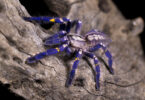Introduction
Tarantulas, with their impressive size and intimidating appearance, have long fascinated and sometimes terrified humans. These arachnids are found in various parts of the world and come in many species. While the mere sight of a tarantula can send shivers down the spine of many, understanding the distinction between venomous and non-venomous tarantulas is crucial for enthusiasts and those who may encounter them in the wild. In this article, we’ll explore the intriguing world of tarantulas, their venomous capabilities, and the importance of demystifying these misunderstood creatures.
The Fascinating World of Tarantulas
Tarantulas belong to the family Theraphosidae, a group of spiders known for their large size and impressive diversity. They can be found on every continent except Antarctica and inhabit various environments, from tropical rainforests to arid deserts. Tarantulas have evolved over millions of years to adapt to multiple ecosystems, resulting in a broad spectrum of species with unique characteristics.
The Anatomy of Tarantulas
Before we dive into the topic of venomous and non-venomous tarantulas, let’s first take a closer look at the anatomy of these arachnids. Understanding their physical features is essential for distinguishing between different species and grasping how their venom works.
Size and Appearance
Tarantulas are generally recognized for their imposing size, with some species having leg spans of up to 10 inches or more. Their body consists of two main parts: the cephalothorax and the abdomen. The cephalothorax houses the spider’s eyes, fangs, and legs, while the stomach contains the spider’s vital organs and silk-producing glands. Most tarantulas have four pairs of legs, which they use for mobility and prey capture.
Fangs and Venom Glands
The most distinctive feature of a tarantula’s cephalothorax is its formidable fangs. These chelicerae are used for capturing and immobilizing prey. Connected to the fangs are venom glands that produce venom, injected into their game through the hollow fangs. The composition and potency of this venom vary widely among different tarantula species.
Venomous Tarantulas
Some tarantula species are classified as venomous, meaning they have potent venom that serves to paralyze or kill their prey. Venomous tarantulas typically belong to the subfamily Selenocosmiinae, and many are native to Asia. Here are some critical characteristics of venomous tarantulas:
Venom Composition
Venomous tarantulas possess venom that can be used to incapacitate prey. This venom primarily contains neurotoxins that target the nervous systems of their victims, rendering them immobile. The potency of the toxin can vary significantly between species, with some being relatively harmless to humans while others can cause severe reactions.
Venomous Species Examples
Indian Ornamental Tarantula (Poecilotheria regalis)
Native to India and Sri Lanka, this tarantula is known for its striking blue and yellow coloration. Its venom is potent, and a bite can cause intense pain, muscle cramps, and other symptoms in humans.
Brazilian Wandering Spider (Phoneutria spp.)
These are not true tarantulas but are often included in discussions due to their large size and potent venom. The Brazilian wandering spider is known for being highly venomous and having a neurotoxic venom that can cause paralysis or even death if not treated promptly.
King Baboon Tarantula (Pelinobius muticus)
This tarantula, native to Africa, is famous for its aggressive nature and potent venom. A bite from a King Baboon Tarantula can lead to severe local pain and other symptoms.
Human Reactions
While venomous tarantula bites can be painful and cause discomfort, they are generally not life-threatening to humans. However, individual reactions can vary, and some people may experience more severe symptoms than others. It is essential to seek medical attention if bitten by a venomous tarantula, especially if the bitten individual shows signs of an allergic reaction or experiences difficulty breathing.
Non-Venomous Tarantulas
Most tarantula species are considered non-venomous, meaning their venom is relatively harmless to humans. These tarantulas often employ other means, such as physical force, to capture and subdue their prey. Here are some critical characteristics of non-venomous tarantulas:
Mild Venom or Venomless
Non-venomous tarantulas typically have mild venom or are virtually venomless. Their venom serves primarily for digestive purposes rather than immobilizing prey.
Non-Venomous Species Examples
Chilean Rose Tarantula (Grammostola rosea) this famous pet tarantula is native to Chile and is known for its docile nature and striking pink coloration. While it has venom, its bite is generally considered no worse than a bee sting for humans.
Human Reactions
Non-venomous tarantulas pose minimal danger to humans. Their bites may cause localized pain, redness, and swelling, similar to a bee sting. However, allergic reactions can occur in some individuals, so it is advisable to seek medical attention if bitten.
The Importance of Proper Identification
Proper identification of tarantula species is essential when dealing with these creatures, whether in captivity or the wild. Misidentifying a tarantula as venomous when it is not can lead to unnecessary fear and potentially lethal consequences for these fascinating arachnids.
For Pet Owners
For those who keep tarantulas as pets, understanding the species you are caring for is vital. This knowledge helps ensure you provide the appropriate habitat, care, and handling for your pet tarantula. If you are still determining the species, consult with an experienced tarantula enthusiast or an expert to accurately identify it.
In the Wild
In regions where tarantulas are native, proper identification can prevent unnecessary harm to these creatures. Many tarantula species play critical roles in their ecosystems, contributing to pest control and serving as prey for other wildlife. Accurate identification helps conserve these species and their habitats.
Handling Tarantulas
Whether you have a pet tarantula or encounter one in the wild, handling these arachnids requires care and respect. Here are some essential guidelines for handling tarantulas safely:
Pet Tarantulas
Approach with care: When handling a pet tarantula, be patient and gentle. Use a soft paintbrush or your hands if necessary. Never use force, and avoid sudden movements.
Wild Encounters
Observe from a distance: In the wild, it’s crucial to observe tarantulas from a safe distance. Use binoculars or a camera with a telephoto lens to study these fascinating creatures without disturbing them.
Venom and Health Considerations
In the event of a tarantula bite, it’s essential to know how to respond to ensure your safety and well-being:
Venomous Tarantula Bites
If bitten by a venomous tarantula, follow these steps:
Panic can worsen the situation and increase your heart rate, potentially spreading the venom more rapidly. Clean the bite area with soap and water to prevent infection. If the bite occurred on a limb, elevate it to reduce swelling. Placing a cold compress on the wound can help alleviate pain and reduce swelling. Seek medical attention: Even though most venomous tarantula bites are not life-threatening, it’s essential to seek professional medical care. The doctor can assess the severity of the bite and provide appropriate treatment.
Non-Venomous Tarantula Bites
Bites from non-venomous tarantulas are typically less severe, but you should still take the following precautions:
Clean the bite area with soap and water to prevent infection. Use an antiseptic to reduce the risk of infection further. Keep an eye on the wound for signs of allergic reactions, such as increased redness, swelling, or difficulty breathing. Seek medical help if these symptoms occur.
Conclusion
Tarantulas are captivating arachnids with a wide range of species, each possessing unique characteristics and varying levels of venom potency. Understanding the difference between venomous and non-venomous tarantulas is essential for their conservation and for safely interacting with them, whether in captivity or the wild. By promoting accurate identification, responsible handling, and awareness of their importance in ecosystems, we can demystify these misunderstood creatures and ensure their survival for future generations to appreciate and admire. Tarantulas play a crucial role in the intricate web of life on our planet, and it is our responsibility to protect and respect them.






